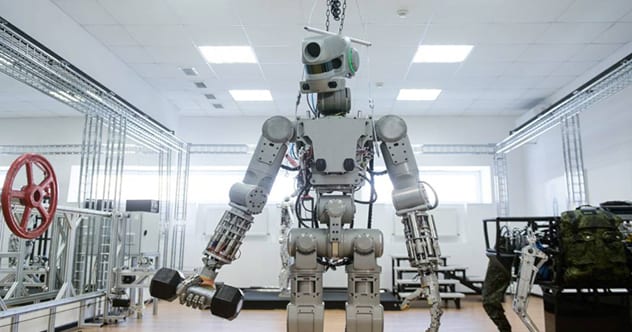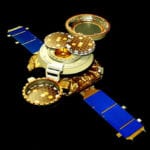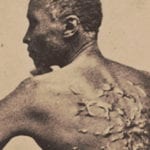 Weird Stuff
Weird Stuff  Weird Stuff
Weird Stuff  Our World
Our World 10 Ways Your Christmas Tree Is More Lit Than You Think
 Movies and TV
Movies and TV The 10 Coolest Stars to Set Sail on The Love Boat
 History
History 10 Things You Didn’t Know About the American National Anthem
 Technology
Technology Top 10 Everyday Tech Buzzwords That Hide a Darker Past
 Humans
Humans 10 Everyday Human Behaviors That Are Actually Survival Instincts
 Animals
Animals 10 Animals That Humiliated and Harmed Historical Leaders
 History
History 10 Most Influential Protests in Modern History
 Creepy
Creepy 10 More Representations of Death from Myth, Legend, and Folktale
 Technology
Technology 10 Scientific Breakthroughs of 2025 That’ll Change Everything
 Weird Stuff
Weird Stuff Ten Bizarre Facts About The Doge Meme
 Our World
Our World 10 Ways Your Christmas Tree Is More Lit Than You Think
 Movies and TV
Movies and TV The 10 Coolest Stars to Set Sail on The Love Boat
Who's Behind Listverse?

Jamie Frater
Head Editor
Jamie founded Listverse due to an insatiable desire to share fascinating, obscure, and bizarre facts. He has been a guest speaker on numerous national radio and television stations and is a five time published author.
More About Us History
History 10 Things You Didn’t Know About the American National Anthem
 Technology
Technology Top 10 Everyday Tech Buzzwords That Hide a Darker Past
 Humans
Humans 10 Everyday Human Behaviors That Are Actually Survival Instincts
 Animals
Animals 10 Animals That Humiliated and Harmed Historical Leaders
 History
History 10 Most Influential Protests in Modern History
 Creepy
Creepy 10 More Representations of Death from Myth, Legend, and Folktale
 Technology
Technology 10 Scientific Breakthroughs of 2025 That’ll Change Everything
Top 10 Infrastructure Projects That Built America
The United States Congress is en route to doing something truly incredible: passing a major bill along bipartisan lines. In mid-August, the U.S. Senate – a body currently split 50-50 between Republicans and Democrats, and which requires 60 votes to pass most legislation – passed a $1 trillion infrastructure bill to update the country’s roads, bridges, tunnels and water systems. The House voted to advance the bill, setting it up for final passage.
While I’d settle for not feeling like I’m in an earthquake every time I drive on local highways, America has a long history of breaking ground on groundbreaking infrastructure projects – ones that helped shape the nation. Here are ten, in chronological order.
Related: Top 10 Tremendous Wastes Of Money
10 The Erie Canal (1825)
The most important infrastructure project in New York City’s history was constructed hundreds of miles from New York City.
In the early 1800s, personal travel was slow and commercial freighting even slower. In areas lacking direct water routes, large quantities of goods were hauled by oxcart and other millennia-old methods. The result was a double-edged sword: coastal cities couldn’t easily access the American interior’s vast resources, and would-be western settlers hesitated to sever themselves from major coastal markets.
Seeing this untapped potential, New York State governor DeWitt Clinton fiercely advocated for a 363-mile canal linking the Great Lakes at Buffalo to the Hudson River at Albany. The eight-year, $7 million engineering feat cut through fields, forests, cliffs and swamps, conquering inclines with more than 80 lift locks.
The Erie Canal was completed in 1825. Nearly overnight, shipping costs along the route plunged 90 percent, and travel time was more than halved. Freight boats carried products from Buffalo to Albany then, pulled by tugboats, continued to New York City, which quickly became the country’s preeminent commercial center and quadrupled its population by 1850.
In turn, those long wishing to settle western lands could now do so without sacrificing access to such a critical market. Farmers, loggers, miners and manufacturers flocked not only to western New York State but other points along the Great Lakes like Ohio and Michigan. The Erie Canal almost singlehandedly earned New York its moniker: The Empire State.
9 Transcontinental Railroad (1869)
America’s first steam locomotive premiered in 1830 and, by 1850, 9,000 miles of track existed east of the Missouri River. Rail’s rapid growth made an ongoing network of ancillary canals – marine byways to supplement the Erie Canal’s smashing success – increasingly obsolete.
Connecting the entire continental country by rail would have taken longer were it not for one event: the 1848 discovery of gold in California. The ensuing westward rush allowed California to achieve full statehood by 1850; until then, the westernmost states were Texas, Wisconsin and Iowa. Calls came to connect the sister states with track, toward the dual goal of faster, safer travel to the Pacific coast and the settlement of the vast lands in between established states.
Abraham Lincoln answered that call, greenlighting arguably America’s most significant infrastructure project during what was inarguably its most existential crisis, the Civil War. In 1862, Lincoln signed the Pacific Railway Act, chartering two entities – the Central Pacific and Union Pacific Railroads – to connect the California capital of Sacramento to the then-westernmost rail hub at Omaha, Nebraska.
The two companies raced toward each other. Along the way, they fought off waves of attacks from Native Americans understandably hostile to invaders laying tracks for their “iron horses.” Civil War veterans, Irish immigrants and some 14,000 Chinese completed the 1,912-mile route in seven years; some 1,200 died in the process. Overnight, the 3,000-mile cross-country journey fell from several months to under a week, vastly accelerating America’s westward expansion.
8 The Prison System (1891)
Not all infrastructure is good infrastructure. One out of every 142 Americans is currently incarcerated – the highest per capita prison population in the world, exceeding that of such advanced countries as El Salvador, Turkmenistan and Rwanda. And despite being a distant third in national population – behind two countries, China and India, with over a billion people – America’s prison population of 2.3 million is higher than any other nation. USA! USA!
There are several historical flashpoints for how we got here, but from an infrastructure standpoint 1891 is a significant date. That year, the Three Prisons Act created the Federal Prisons System, opening the first three federal prisons at Leavenworth, Kansas; McNeil Island, Washington; and Atlanta, Georgia.
Today, the American criminal justice system comprises 1,833 state prisons, 110 federal prisons, 1,772 juvenile correctional facilities, 3,134 local jails, 218 immigration detention facilities, 80 Indian Country jails, and a smattering of military prisons.
The reason, of course, is not that America has more crime than El Salvador – which, in fact, is the world’s most dangerous country. America’s incarceration fixation stems from a variety of factors, including public-private collaborations with monetary incentives to mete out excessive sentences; a cash bail system that leaves poor people accused of low-level crimes locked up for long pre-trial stretches; and the failed decades-long War on Drugs that handcuffed judges with lengthy mandatory sentences even for nonviolent offenders.
7 New York City Subway (1904)
While Boston boasts America’s oldest subway – its underground rail system dates to 1897 – New York City’s is by far the most extensive and mission-critical.
NYC’s subway opened in October 1904. Its inaugural line serviced 28 stations along a nine-mile route, beginning at Lower Manhattan’s City Hall before heading north to Grand Central Station, west to Times Square then north again to Harlem. Soon, service expanded to the city’s newly incorporated boroughs, which until 1898 were standalone entities; the subway reached the Bronx in 1905, Brooklyn in 1908 and Queens in 1915.
While the Erie Canal helped establish New York City as America’s premiere city, the ever-growing underground passenger rail network was vital to maintaining that mantle. As new lines stretched into every corner of the city, a commuter culture took root that made New York something many large cities weren’t: self-contained and eminently livable.
Today, the NYC Subway comprises 25 lines (Boston has a grand total of four) servicing a dizzying 472 stations – the most in the world. Its map has confused many a tourist. The system includes more than 650 miles of track and, each weekday, more than 5.5 million passengers ride its nearly 6,500 subway cars. And unlike most major cities’ subways, NYC’s runs around the clock.
The NYC Subway is, simply, the single most important transportation system in the country – the physical engine powering its economic one.
6 The Los Angeles Aqueduct (1913)
At the turn of the 20th Century, Southern California had exceedingly high hopes… but exceedingly little water. For the arid region to attain anything approaching the stature of northerly rival San Francisco, it needed much more of the most mission-critical resource on Earth.
City officials’ solution was the $23 million Los Angeles Aqueduct. Completed in 1913, the five-year initiative diverted water from the Owens River, leading it along a 233-mile journey southwest. At its busiest, construction employed some 3,900 laborers creating 11 lengthy stretches of canal and half a dozen storage reservoirs. Impressively, the water was funneled using nothing except gravity – and that waterflow generates electricity that helps offset operating costs.
In the decades following the aqueduct’s completion, Los Angeles grew not only in size by territory; in fact, its area grew more than sevenfold, from 61 square miles to 440. This was because the city’s charter required those communities utilizing the aqueduct’s waters to annex themselves into Los Angeles proper.
Bolstered in the 1960s with an expansion to maximize its allocated water volume, today the aqueduct remains a crucial part of LA’s infrastructure, supplying nearly 30% of water needs for the city of four million. Unfortunately, as the area descends even further into drought likely due to climate change, the aqueduct’s continued operation has led to court battles over water share disparities and environmental impacts.
5 The Hoover Dam (1936)
Like the Los Angeles Aqueduct, the Hoover Dam was born of the necessity to first tame the Wild West in order to settle it on a Manifest Destiny-level scale. While best known as a power plant, the massive dam also served to help control regular, devastating flooding along the 1,450-mile Colorado River and, in doing so, diverting its waters to arid areas that, otherwise, would have been unable to support significant population growth.
The thing is, in a word, massive. More than seven stories high and nearly a quarter-mile long, the Hoover Dam required enough concrete to construct a four-foot-wide sidewalk around the ENTIRE WORLD. At its top, the dam is 45 feet thick – equivalent to a four-lane highway; at its base, it is an impenetrable 660 feet thick – nearly double the length of a soccer pitch.
Incredibly, the Hoover Dam was completed in just five years, about the same time ill-defined, questionably-necessary and unquestionably disruptive roadwork has been occurring near my New Jersey home. The dam’s pace, however, came with a price: as many as 138 people died during its construction.
The Hoover Dam’s impact was immense and immediate – an importance exemplified by the fact that, before America entered World War II, a Nazi plot to blow it up was fortunately foiled. The Third Reich’s goal was to cut off crucial electricity to California’s burgeoning airplane manufacturing industry, imperiling America’s ability to defend itself or wage war.
4 Interstate Highway System (1956)
Soon after the first Model T rolled off the assembly line in 1908, it became apparent the car would dominate American culture. In 1916, the Federal Aid Road Act authorized construction of interconnecting local roadways; five years later, a follow-up law expanded the effort to include major thoroughfares. In 1926, the first numbered highways appeared, establishing modern navigation route guidelines.
But the most ambitious and consequential roadway construction commenced when President Dwight Eisenhower signed the Federal Aid Highway Act of 1956, commonly known as the Interstate Highway Act. The goal was standardization and interconnectivity on a national level. A departure from stop-and-go travel, the new highways were controlled-access expressways with no at-grade crossings – abandoning intersections in favor of over- and underpasses.
The initiative was not without controversy. In densely populated areas, some new freeways required demolishing well-established neighborhoods. In New York, the powerful urban planner Robert Moses had designs on a 10-lane highway cutting straight through Lower Manhattan. Fortunately those plans were thwarted.
Another consequence was unforeseen: as convenient roadways sprung up around major urban centers, middle-class Americans – most of whom were white – began an exodus to commuter communities outside city limits. Known as “white flight,” the rise of widescale American suburbia paralleled with downturns in many major cities. Still, the system’s benefits – efficient travel, less congested roads, decreased commercial shipping costs and times – modernized the culture and economy in ways both necessary and inevitable.
3 National Parks Roadways & Recreation Areas (1956)
As interstate highways crisscrossed the country, Americans took to the roads like never before. This newfound geographical freedom coincided with unprecedented leisure time – a result of the post-World War II economic boom that gave labor unions and individual professionals leverage to secure higher wages and vacation time for workers.
Still a decade or so away from affordable commercial airline travel, Americans packed their bags, hopped in their cars and drove. And a hell of a lot of them ventured to America’s proudest treasures: its national parks. By 1955, annual national parks visitation was 56 million – up from just 21 million in 1941.
Unfortunately, the parks simply weren’t ready for them. Overcrowding and scant recreation areas mixed with a dearth of navigable roads within the parks. Accessible areas became littered and polluted while inaccessible areas remained… well, inaccessible.
So in 1956, National Park Service director Colin Wirth proposed a ten-year plan – called “Mission ‘66” after its planned completion date – that invested hundreds of millions of dollars in widescale infrastructure improvements. The effort dramatically increased not only nature-friendly access roads but staffing, maintenance and visitor centers.
In a nation with a less-than-stellar record of protecting pristine wilderness, the US government successfully saved national parklands while helping Americans visit them more enjoyably and sustainably.
2 Nuclear Power Plants (1958)
Surprisingly, the US was actually third to the nuclear power plant game, behind the Soviet Union (1954) and the United Kingdom (1957). However, the US quickly became the world’s foremost generator of nuclear energy, peaking in 2012 with 104 functioning reactors. Today, America’s 96 operational reactors are still the most on Earth and, at nearly 100,000 MW, produces about 20% of the country’s electricity.
Despite reasonable safety concerns including the creation of radioactive waste and, of course, the possibility of a Chernobyl or Three Mile Island-esque meltdown, the proliferation of nuclear power is more important than mere electricity generation. The successful construction and operation of the vast majority of nuclear power plants taught the world a lesson that, in the here and now, is invaluable: that energy can be produced with zero carbon emissions.
As countries across the world try to expand green energy production, the US has a long way to go if it wants to lead a sustainable energy surge necessary to avoid the worst effects of climate change. Currently, America generates only 20% of its energy through renewable resources like hydro, wind and solar.
By comparison, Iceland and Norway generate all of their electricity using renewable energy resources, and nearly 50 other nations generate over 50% of their electricity from renewables. Recently, US President Joe Biden announced plans to drastically increase renewable production, including intentions to generate 40% of the country’s electricity via solar energy by 2035.
1 Vaccine Manufacturing & Distribution (2020)

The effort to develop effective vaccines against a contagious novel virus is among medical science’s finest accomplishments to date. But having an effective vaccine and delivering it are two very different things. And regardless of anyone’s opinions of former President Trump’s overall handling of the coronavirus situation, his Operation Warp Speed was wildly successful.
First and foremost, Operation Warp Speed’s mission was securing sufficient doses of an eventual vaccine. Despite globalists screeching over vaccine “hoarding,” a nation’s government’s first duty is to protect its own people, period.
But past that, the program provided additional funds for two things: US-based vaccine manufacturing and nationwide distribution. Regarding the former, by March 2021 the US had produced more than 100,000,000 vaccine doses – second only to communist China (the source of the disease), whose vaccine, called Sinovac, is comparative garbage.
The US also stood out in its ability to distribute and administer the vaccines. For the two most common vaccines – next-gen concoctions from Pfizer and Moderna called mRNA vaccines – this involved a far-reaching cold chain support and patient administration system. For example, the initial rules for Pfizer’s vaccine necessitated it be kept at -70° C – colder than the South Pole – and, once thawed, used in five days. America’s exemplary medical infrastructure and human resources oversight helped it far outpace other first world countries’ vaccination rates in the weeks and months following initial FDA emergency approval.








